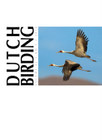Dutch Birding volume 32 (2010) no 1

Black-faced Bunting at Castricum in November 2007 and identification of subspecies
On 18 November 2007, a Black-faced Bunting Emberiza spodocephala was trapped at Castricum, Noord-Holland, the Netherlands. After ringing and measuring, descriptions, videos and photographs were taken and the bird was sound-recorded at release. It was separated from other buntings by its short and rounded wing-tip, four emarginated primaries, relatively slender-based bicoloured bill, medium grey mid-crown stripe, hindneck and side of neck, obvious pale grey supercilium and off-white malar stripe, almost uniform buff-grey rump, large white wedge on two outermost tail-feathers, and call. It was identified as a female based on: 1 blackish shaft-streaks to central crown, each of which ending in a black triangular terminal mark (in male, crown-feathers are uniform grey or olive-green, except for squarish dot on tip, bordered by some rufous at sides; in both sexes, terminal triangles and dots wear off in spring, central crown of female becoming streaked, of male unmarked); 2 prominent pale grey supercilium and off-white submoustachial stripe (side of head more uniform grey in male); 3 white central throat (in male, throat to upperbreast grey, as continuation of grey head-sides); and 4 absence of narrow black rim or small mask along base of bill or of black on lore (males often have small mask, development dependent on age, time of year and subspecies, sometimes restricted to black loral patch in spring only). Based on the narrow tail-feathers with pointed tips, frayed brown fringes to the dull black greater coverts and greater primary coverts, and grey-brown iris, it was aged as first-year.
Its characters were compared with descriptions of specimens from the breeding grounds made in the collections of the zoological museums of Amsterdam, Berlin, Leiden, Tring and Vienna. In all plumage features, it resembled E s oligoxantha, the subspecies breeding nearest to Europe in Central Siberia, Russia. This subspecies is characterized by the predominantly grey forehead to mantle, side of head and (in male) throat, without green or olive suffusion, and pure white belly to undertail-coverts, virtually without any yellow. All other subspecies differ in being distinctly washed olive-green above and on the side of head and by extensive pale yellow on the underparts, sordida from Central China and personata from Japan also by a thicker bill, personata also by showing much less white on the outer two tail-feathers.
An overview is given of all 15 other European records (table 1), with an assessment of the subspecies involved as far as could be ascertained from descriptions or published photographs.
C S (Kees) Roselaar, Zoölogisch Museum, Universiteit van Amsterdam, Postbus 94766, 1090 GT Amsterdam, Nederland
(c.s.roselaar uva.nl)
uva.nl)
Jan Visser, Weiver 10b, 1546 LB Jisp, Nederland
(jan.visser hetnet.nl)
hetnet.nl)
Arnold Wijker, Bergstraat 31, 1931 EN Egmond aan Zee, Nederland
(awijker quicknet.nl)
quicknet.nl)
VRS Castricum, p/a Bergstraat 31, 1931 EN Egmond aan Zee, Nederland
(vrscastricum tiscali.nl)
tiscali.nl)
terug






